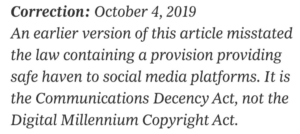Why Do So Many Section 230 Stories Contain Corrections?
CNN:
As the Cato Institute cataloged last month, prestigious outlets reporting on the Telecom Act’s ‘Good Samaritan’ provision, Section 230, have had to issue corrections due to fundamental misstatements of the law. The New York Times (in an article and an op-ed), the Washington Post (in an op-ed), the Wall Street Journal (in an op-ed), and CNN (in an article) all made substantial substantive errors in reporting on Section 230. Prof. Ryan Calo likened the repeated corrections to “an op[-]ed about particle physics confused neutrons and electrons.”
The “paper of record” getting it wrong can have serious consequences—even for pieces where a correction is later added. In a Twitter thread, Section 230 expert Prof. Jeff Kosseff noted last week that a federal court in New Jersey recently cited the faulty analysis on Section 230 from the August 6 NYT article.
In reality, as Sarah Jeong explained recently, “Section 230 of the C.D.A. is neither long nor particularly inscrutable.” Internet services that allow users to post third-party content rely on Section 230’s ‘Good Samaritan’ protections to be able to moderate or remove content like hate speech or extremism. It also allows online services to operate without the risk of being held liable for the misconduct of any bad actor who might use its service.
Section 230 says two things: (1) that online services should not be held liable for the misconduct of users, and (2) that they should not be liable for actions taken to limit inappropriate content. This two-prong approach ensures that companies with varying levels of resources can address problematic online content in ways most appropriate for their particular service, and that no company’s efforts will be held against it when the inevitable mistaken moderation decision occurs.
But for Section 230, online services could be sued by plaintiffs for removing anything from extremist content to pornography to fraudulent schemes. Section 230 also ensures that different services will take different approaches to content moderation.
However, the frequency of inaccuracy in articles on this subject happens more often than one would expect for a law that is not that complex. One possible explanation is that reporters work more from critics or activists’ characterizations of the provision, rather than what it actually is. The aforementioned New Jersey district court relying on one such mischaracterization suggests that this strategy has been successful.
As security expert Alex Stamos put it: “The last six months of every major outlet misunderstanding CDA 230 (always in the self-serving direction) and it’s [sic] impact on content moderation doesn’t give folks a lot of confidence that the coverage is fair.”
Numerous journalists get the law right. For example, WaPo’s Tony Romm reported on Section 230 and accurately summarized the statute as protecting online services “from lawsuits over what their users post online, while granting them a legal green light to moderate their platforms without facing liability.” As mentioned above, NYT’s Sarah Jeong wrote a thoughtful piece about the Section 230 debate, and WSJ also published an op-ed from Andy Kessler responding to Section 230 critics. Vox’s Jane Coaston has also been on the Section 230 explainer beat, after having her first article on the topic go through some revisions a few months ago.
*Update: October 11, 2019: The New York Times’ inability to accurately cover this issue persists. Last week, the Times had to issue an identical correction regarding conflation of the Section 230 intermediary protection with a copyright law provision, less than two months after the first ran on August 7:












